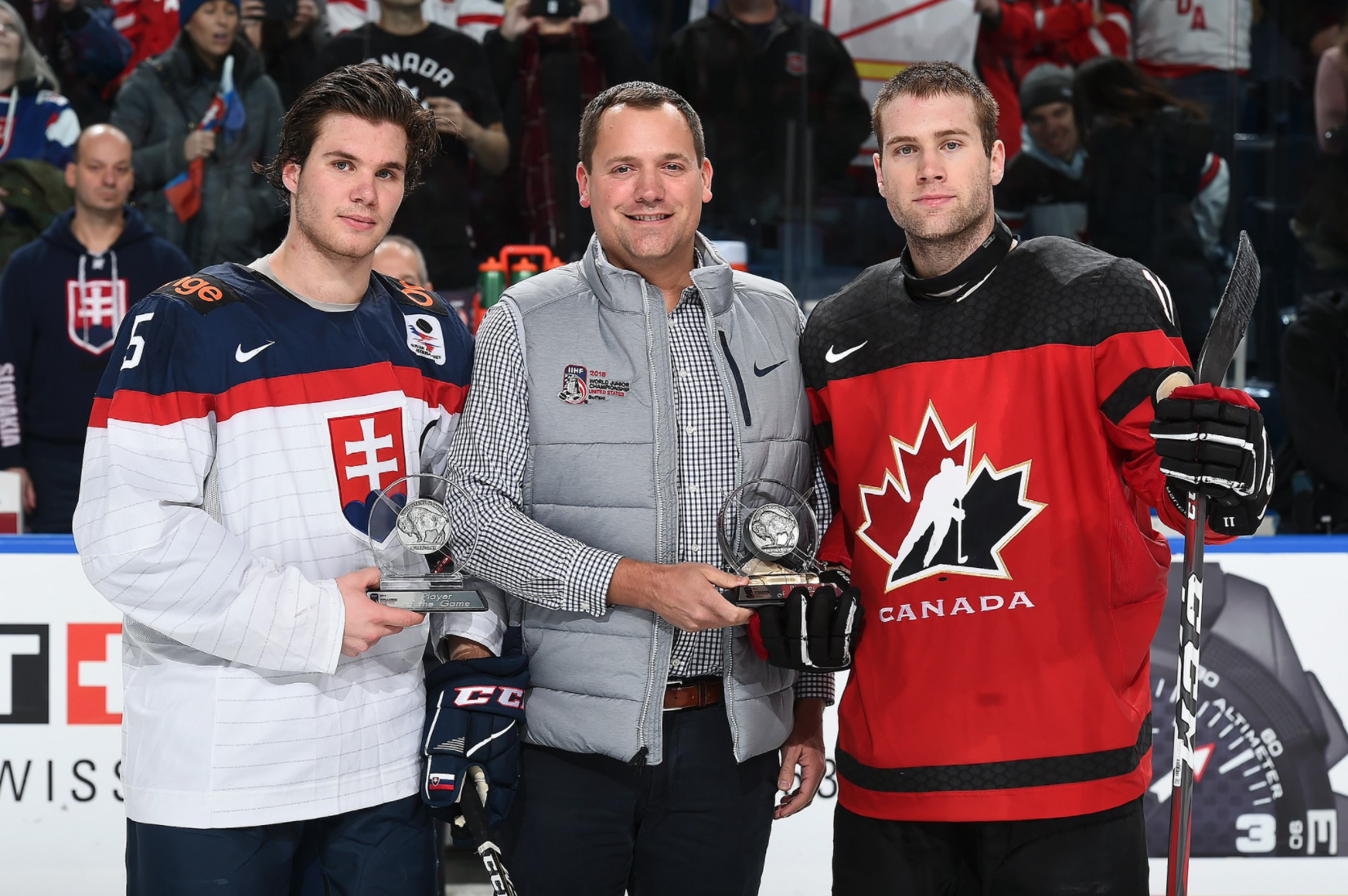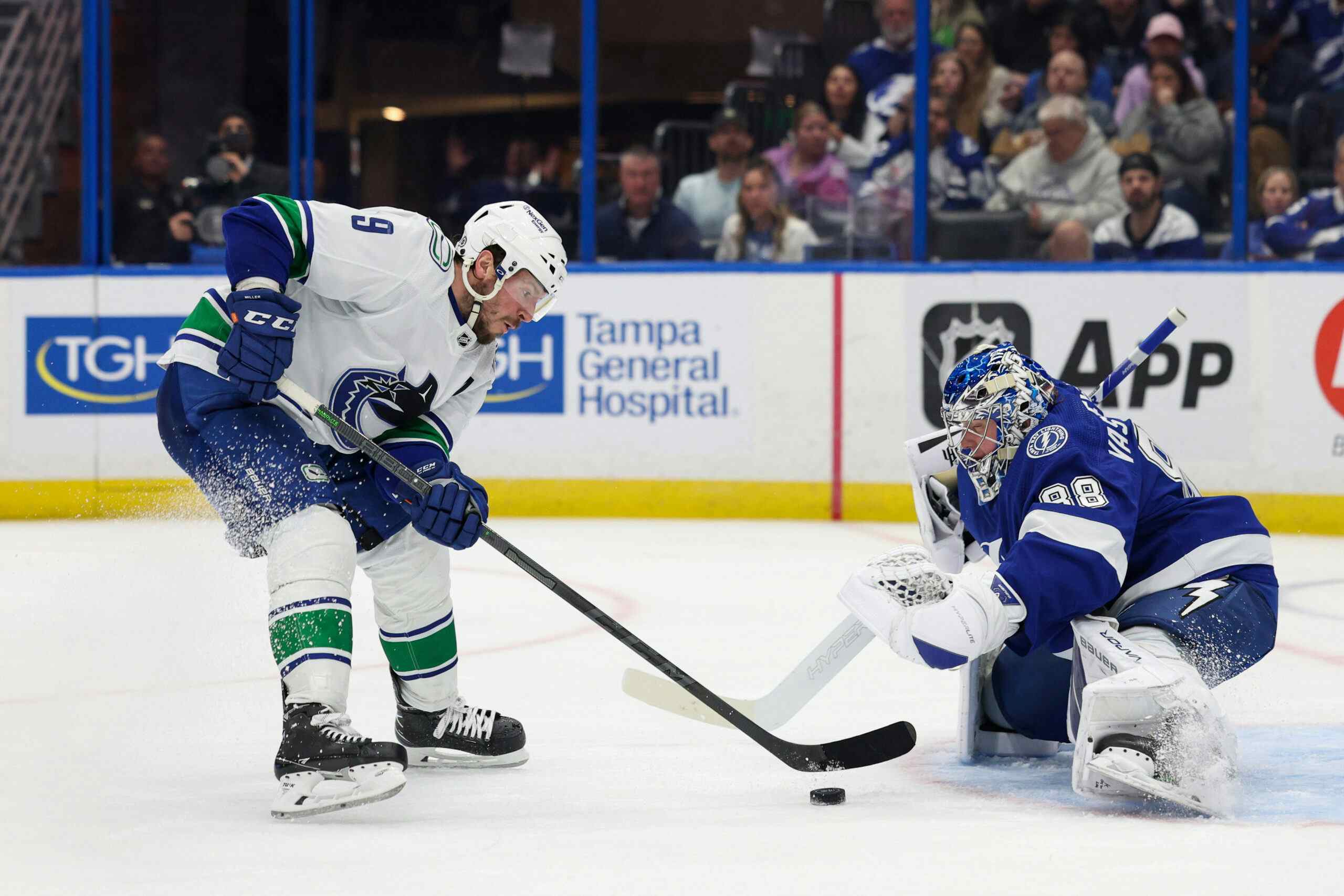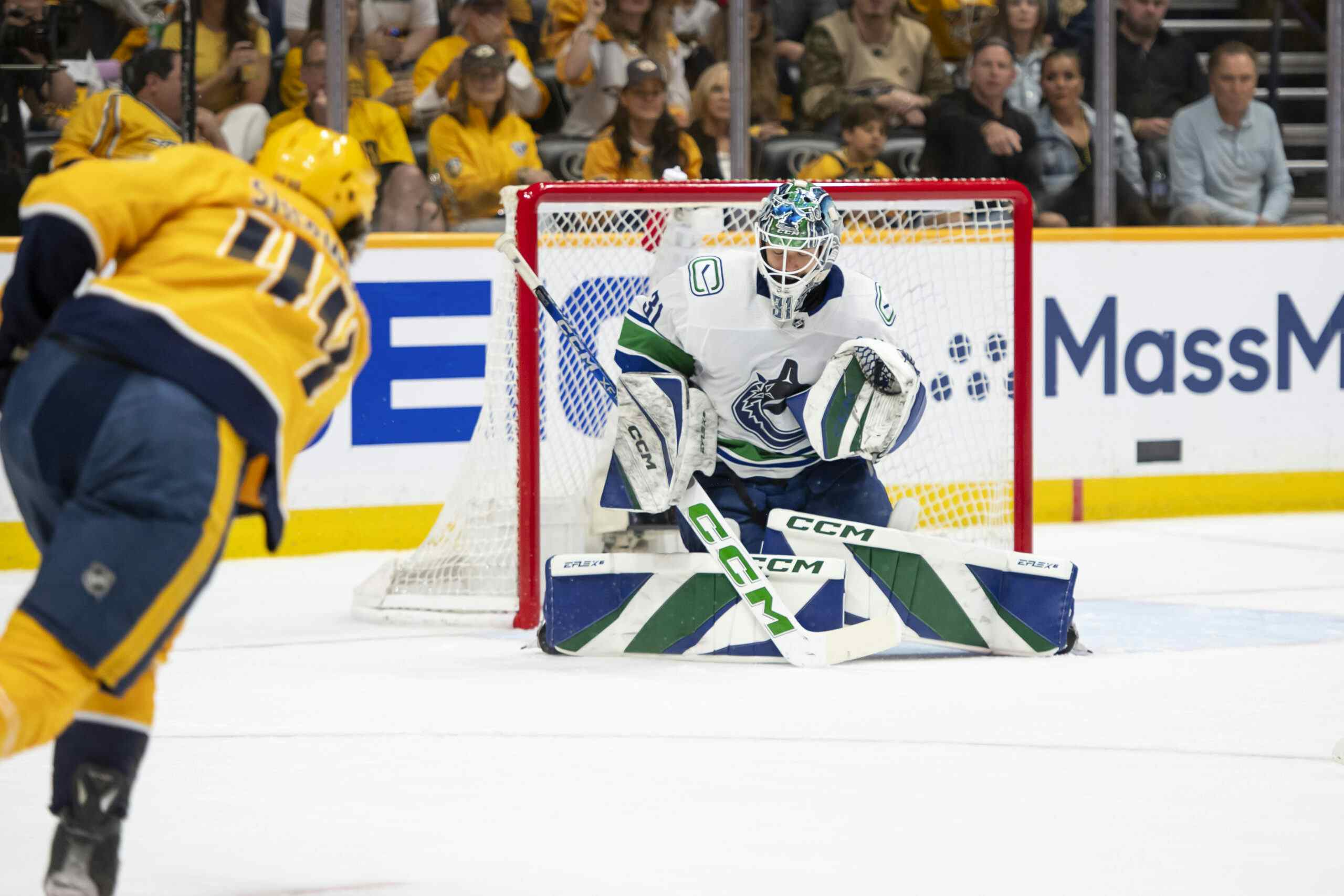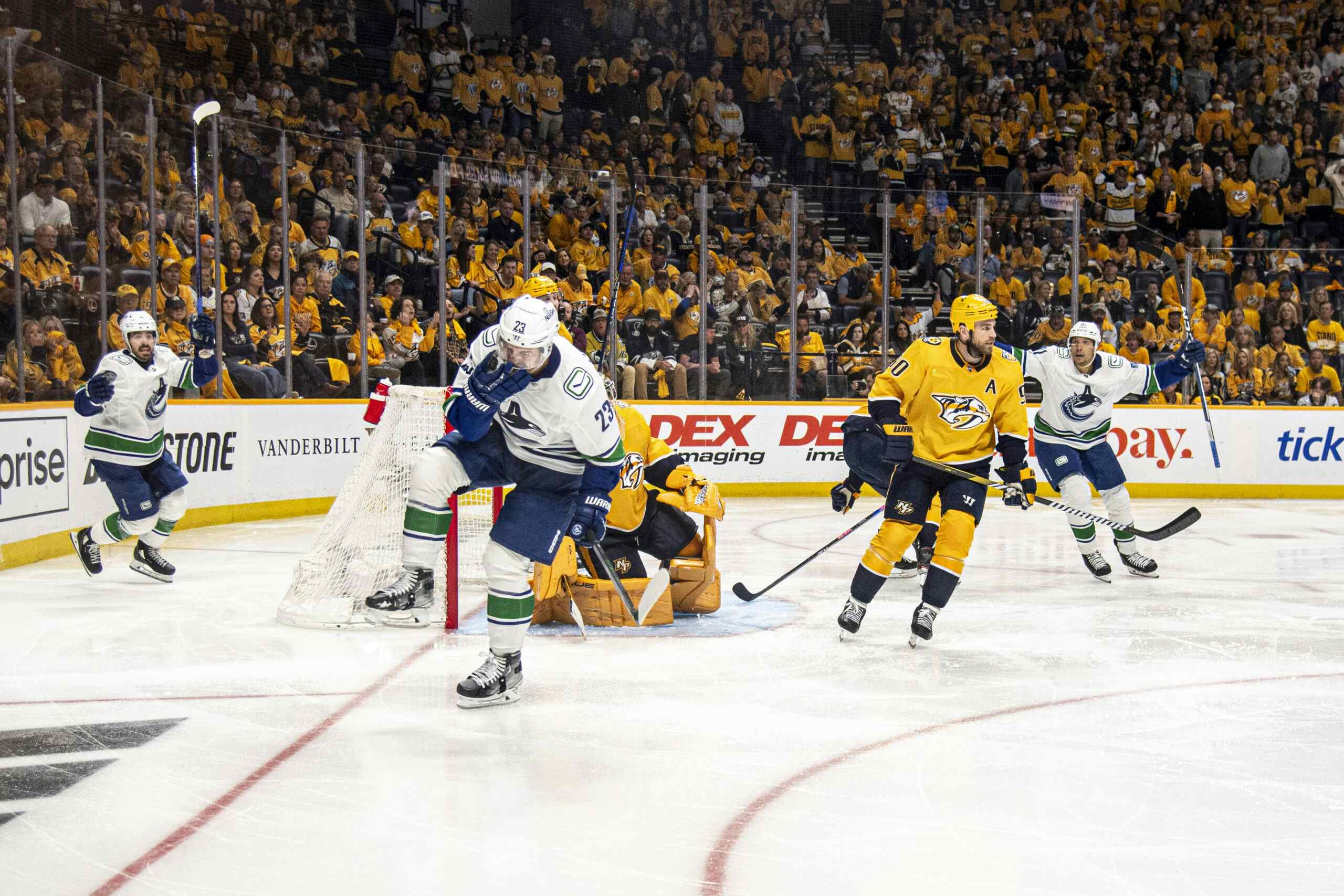2018 World Junior Hockey Championship: Scout’s Notebook

The 2018 IIHF World Junior Championship saw two Vancouver Canucks prospects – Jonah Gadjovich for Team Canada and Elias Pettersson for Team Sweden – squaring off in the gold-medal game. Fellow Canucks prospect William Lockwood won bronze with Team USA, and Olli Juolevi had some promising showings with Team Finland, despite being eliminated in the quarter-final.
But, Vancouver’s prospects weren’t the only ones worth watching.
Here are some thoughts on the players that impressed the most.
Team Canada
Jonah Gadjovich, LW, Vancouver Canucks
Depending on who you ask, scouts may tell you that Gadjovich was a slight reach at 55. His biggest knock was his skating, as he isn’t overly fast, and most see him as nothing more than a net-front presence who can bang in rebounds – hopefully at the NHL level. At the World Juniors, Gadjovich proved he can be more than that.
In the clip above, Gadjovich moves into the open space quickly and starts a rush. He doesn’t fly like Connor McDavid, but his speed sure doesn’t look as bad as it’s often made out to be.
Equally great news: Gadjovich made some really smart plays around the net, displaying strong vision and soft hands to set up his teammates for scoring chances.
Cale Makar, D, Colorado Avalanche
Cale Makar started out as Canada’s seventh defenceman, but he never played like one. Anytime he stepped on the ice, the Avalanche prospect made sure the coaches noticed him. Playing his draft year with the Brooks Bandits in the AJHL, few fans had seen him play going into the draft. But his dynamic play in the offensive zone at this tournament was certainly enough to prove he deserved to be picked fourth overall.
Makar finished the tournament ranked third in scoring for Canada, recording eight points (3-5-8).
Conor Timmins, D, Colorado Avalanche
Colorado has been in need of defensive help for far longer than the Canucks. With Conor Timmins and Makar, it looks like they finally got what they wanted. Unlike Makar, who was outstanding right from the start, Timmins progressed nicely throughout the tournament, finishing off with a fantastic performance in the gold-medal game.
Despite measuring “only” 6-foot-1, Timmins can look quite lanky and occasionally awkward when carrying the puck. Yet, he especially stood out on the breakout, where he frequently beat forecheckers with his mobility and quick bursts of speed.
In addition, Timmins proved he can be a valuable offensive contributor. Here, too, he showed great mobility along with strong offensive awareness and a hard, accurate shot.
Team Sweden
Elias Pettersson, RW, Vancouver Canucks
Pettersson scored a goal-of-the-tournament candidate against Switzerland. He also tied for the Swedish scoring lead with seven points (5-2-7) and had a couple of outstanding wrist-shot goals.
The problem: Pettersson – like fellow seven-point Swedes and linemates Lias Andersson (NYR) and Alex Nylander (BUF) – was dominant on the man advantage, but couldn’t produce much at even strength. Still, Pettersson’s playmaking and shooting skill were always apparent, and Canucks fans have a lot to be excited about when he makes it to Vancouver as early as this year.
Axel Jonsson-Fjallby, LW, Washington Capitals
Jonsson-Fjallby was able to surprise a lot of people with his speed and high-energy game. He displayed a well-rounded tool-kit, providing offence both at even strength and on the penalty kill. A former fifth-round pick, Jonsson-Fjallby projects as a bottom-six contributor and penalty-killer at the NHL level, but he used this tournament to prove his upside may be higher than that.
Rasmus Dahlin, D, 2018 NHL Draft eligible
There wasn’t a doubt about Dahlin’s standing as the top prospect for this year’s NHL draft. But if there was anyone out there he had yet to convince; I’m sure he did. Dahlin wasn’t the typical underager at an under-20 tournament; instead, he frequently led Sweden in ice time and was used as their power-play quarterback on the first unit. All Dahlin did this tournament was add to his highlight tapes.
Timothy Liljegren, D, Toronto Maple Leafs
Liljegren wasn’t much different from Dahlin. He, too, was excellent with the puck, especially as a puck-mover on the breakout. Going into the draft, Liljegren displayed a lot of what Dahlin is doing now, being highlight-reel coast-to-coast rushes. But, the ability to make accurate breakout passes over long distances may be an even more important skill in the NHL.
Once in the offensive zone, Liljegren did everything we’d seen plenty of times in the past. He is incredibly dynamic and has strong vision, making him a constant threat from the blue line.
All that said, Liljegren had the occasional iffy moment as well, and unlike most Leafs fans suggest, he is still more likely to be a second-pairing D-man and power-play specialist in the NHL than the No. 1 defender they’ve been craving.
Team USA
William Lockwood, RW, Vancouver Canucks
I remember being on Twitter when the Canucks picked Lockwood in 2016, and the general consensus among fans was “who is that guy?” Lockwood has been developing nicely since then, looking more and more like someone who can have an impact at the NHL level – at least in a limited role – and he confirmed that at the world juniors, despite missing all but three games due to injury.
As expected, Lockwood wasn’t someone who carried his teammates and created constant danger. He also finished the tournament without a point. However, he used his speed and smarts to get himself into scoring position several times.
Lockwood spent some time on a line with tournament scoring leader and MVP Casey Mittelstadt. While he may just be a bottom-six player and PK-specialist, he also looks like he could be a strong complementary player to a skilled top-six forward, once again reminding of ex-Canuck Jannik Hansen.
Casey Mittelstadt, C, Team USA
Mittelstadt was essentially what I hoped Pettersson would be, and a little bit more. This tournament once again showed it might be smart to go skill-first in the draft and not care too much about how many pull-ups prospects do at the Combine. Mittelstadt’s game is pure skill, and he knows exactly how to use it to benefit both himself and anyone lucky enough to be on the ice with him. That includes both power-play and even-strength situations.
Brady Tkachuk, LW, 2018 NHL Draft eligible
I loved Tkachuk at the U18 worlds in April last year, where he was one of his team’s best players as an underager. At the same time, I wondered about his scoring upside, because what stood out the most was his two-way game and the ability to win puck battles in the corners, without having too much of a scoring drive himself.
At the world juniors, however, Tkachuk completely won me over. He did spend most of his time on Mittelstadt’s left wing, but he was just as much a part of their line’s dominant performances. Tkachuk reminded me a lot of his brother, in how he can be an absolute pest while displaying a scorer’s skill-set that could put him in the NHL as early as next season.
Don’t be surprised to hear his name called in the top three at the 2018 draft.
Quinn Hughes, D, 2018 NHL Draft eligible
Hughes was an interesting case. On the one hand, he made me want to pick him third overall at the 2018 draft, because of his fantastic offensive-zone play and skating ability. But at the same time, he was incredibly shaky defensively, starting on the offensive blue line, which led to many, many scoring chances – and goals – against.
Teams picking in the top five will have to make a decision here: Take a risk for incredible skill and a sky-high ceiling or go with a slightly safer pick?
Team Czech Republic
Martin Necas, C, Carolina Hurricanes
The Czechs were easily the biggest surprise of the tournament, eliminating Finland in the quarters and advancing to the semifinals against Team Canada. Necas was a huge reason why. The Hurricanes prospect tied Mittelstadt for the tournament points lead with 11 (3-8-11) and created non-stop danger on a line with 2018-eligible Filip Zadina. Necas spent almost his entire draft season playing professionally in the Czech league, and appeared in one NHL contest this year.
He’s clearly ahead of most of his peers.
Filip Zadina, LW, 2018 NHL Draft eligible
Zadina was probably the 2018 draft prospect who improved his stock the most. He ranked seventh in the tournament with eight points, including seven goals. Zadina displayed an excellent offensive toolkit, with quick hands and a quick, accurate release. Whoever ends up drafting him is likely to get a player who can score tons of goals and be equally dangerous as a playmaker.
Kristian Reichel, C, 2017 undrafted
Reichel may have gone undrafted last year, but I don’t expect him to be passed over again. The Czech is an extremely fast skater and can handle the puck well at top speed. He’s most noticeable when he gets a chance to pick up the puck early in his own end and just take off with it, which is something teams want in today’s NHL.
Team Finland
Olli Juolevi, D, Vancouver Canucks
Many Canucks fans are still mad about the Juolevi pick, but the Finnish defenceman once again proved he’s better than many thought. He displayed strong defensive awareness and positioning, playing a smart and simple style rather than getting physical. Chris Tanev is proving you don’t need to hit to be successful defensively, and Juolevi looks like he’s got what it takes to play a similar defensive style.
Offensively, Juolevi looked even better. He displayed strong offensive awareness and vision, along with the ability to play hard, accurate passes to set up his teammates. He looked excellent on the power play and, despite playing the same side as Brock Boeser for the Canucks, should help Vancouver on the man advantage going forward.
Henri Jokiharju, D, Chicago Blackhawks
Jokiharju tied for third in scoring for the Finns, recording four points (2-2-4) in several strong offensive showings. The Blackhawks prospect is a dynamic skater who can make defenders miss and create offence from the blue line. Chicago has been able to be competitive for a long time, in part thanks to the perfect use of their late picks in each round, and Jokiharju looks like he’s next in line.
Team Russia
Klim Kostin, RW, St. Louis Blues
Russia wants to play for gold every year, but Kostin was the only player on the roster who looked worthy of that – it wasn’t enough. Russia ended up being the team I saw the least of as well, for different reasons, but anytime I did see them, Kostin was the one player standing out consistently. He finished with eight points (5-3-8) and, having dropped to 31st overall, is making several teams look foolish.
Team Switzerland
Philipp Kurashev, LW, 2018 NHL Draft eligible
Kurashev can be a little hot and cold, and the fact that I only noted him as a standout in one of five games – that one being against Belarus – says a lot. However, he did show flashes of skill every once in so often, and was arguably Switzerland’s best player.
Valentin Nussbaumer, RW, 2019 NHL Draft eligible
Nussbaumer had just one goal and no assists, but the 2019-eligible winger was extremely noticeable. He will only miss the 2018 draft by 11 days, so it’s not like he is crazy young, but that doesn’t make his performance at an under-20 tournament with a weaker team any less impressive. Nussbaumer created offence using his quick hands and strong vision, and should be a part of Switzerland’s roster in the next two years as well.
The one negative I noticed in his game was his acceleration, but I don’t think it’ll prevent him from becoming a very high draft pick in 2019.
Team Slovakia
Samuel Bucek, C, 2017 undrafted
Bucek had a strong tournament, being Slovakia’s only real standout and recording seven points (3-4-7). His biggest success was without a doubt his game-winning goal against Team USA, but that wasn’t the only time he stood out. Bucek displayed quick hands and a nose for the net throughout the tournament. He has seven goals and 20 points as an overager in the USHL so far this season, which isn’t great. But, he probably put himself on the radar of NHL scouts with his world juniors performance.
Milos Roman, C, 2018 NHL Draft eligible
Roman wasn’t nearly as good as the likely first-round picks of the 2018 draft, but he certainly left his mark as well. His excellent puck-handling skill came out in infrequent spurts, but when they did, it was clear why he’s being considered as a second-round selection. Roman has a strong all-around toolkit and displayed the ability to provide offence in multiple ways.
Team Belarus
Andrei Grishenko, G, 2017 undrafted
Grishenko recorded a 5.43 goals-against average along with a .848 save percentage, so he may be an odd choice for a standout. That said, he didn’t get much help from the defence in front of him and should have put himself on the radar of NHL scouts. The 6-foot-2 goaltender displayed strong puck-tracking ability and moved around the crease really well. On the downside, he was a little too aggressive at times, which led to goals against as well.
Ivan Drozdov, RW, 2018 NHL Draft eligible
Standing out at the world juniors while playing on a roster far below average is extremely difficult, but Drozdov did just that. He didn’t display elite offensive skills, but he was great at starting plays in the D-zone and through the neutral zone. A smooth skater with soft hands, he frequently led breakouts, which could make him a strong complementary player on a line with higher-skilled partners.
Team Denmark
Joachim Blichfeld, RW, San Jose Sharks
To be entirely honest, Blichfeld is only on this list because I wanted to include a Dane as well. Blichfeld was expected to be his team’s top player, and while he only finished second in scoring on his team with six points (3-3-6), it’s probably fair to say he was his team’s top player. However, considering he’s been scoring above a point per game in the WHL, I expected a little bit more from him.
Recent articles from Janik Beichler





